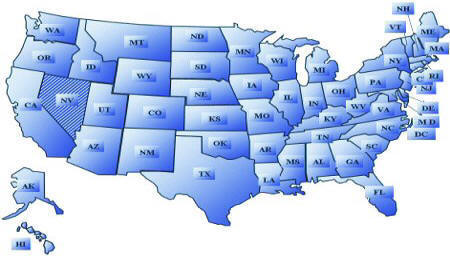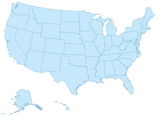California has about 35% of its total surface
area covered by forests. California's diversity of pine species is unmatched
by any other state. Though other states have a higher percentage of their
land area covered by forests, in terms of total area, California contains
more forestland than any other state except Alaska. Most of the forest is
found in 2 places. First, in the northwestern part of the state and along
the western slope of the Sierra Nevada. Smaller forests, mainly consisting
of oaks, can be found along the coast ranges of California closer to the
coast, and also in the foothills of the Sierra Nevada. Smaller areas of pine
forests can be found in the San Gabriel and San Bernardino mountains of
Southern California and also in the mountain areas of Central San Diego
Country.
Deserts in California make up about 25% of the total surface area. In the
south lie the
Transverse Ranges and a large salt lake, the
Salton Sea. The south-central desert is called the
Mojave. To the northeast of the Mojave lies
Death Valley, which contains the lowest, hottest point in
North America. The lowest point of Death Valley and the peak of Mount
Whitney are less than 200 miles apart. The hiking trek between the two points
has been attempted, several times, most notably by
Lee Bergthold. Indeed, almost all of southeastern California is arid, hot
desert, with the
Coachella Valley and
Imperial Valley routinely experiencing extreme high temperatures during the
summer.
Along the densely-populated and long California coast lie a number of major
metropolitan areas, including those of
San Jose-San
Francisco-Oakland,
Los Angeles-Long
Beach, Santa Ana-Irvine-Anaheim, and
San Diego. Climates near the
Pacific Ocean are remarkably moderate compared with inland climates. Winter
temperatures never reach freezing (snow is virtually unheard of) and summer
temperatures rarely reach above the high 80's Fahrenheit (low 30's Celsius).
California is famous for
earthquakes due to the presence of a number of faults, in particular the
San Andreas Fault. While powerful earthquakes in the United States have
occurred in other states such as
Alaska,
Washington,
Oregon, and the Midwestern state of
Missouri, (along the
New Madrid fault), people are more aware of California's earthquakes due to
their frequency and tendency to strike in highly populated areas. Some people
believe that a huge, inevitable earthquake will result in the splitting of
coastal California from the continent, either to sink into the ocean or form a
new island. Notable movies in which the possible destruction of much of
California by an earthquake include the titles
Earthquake,
A View to a Kill,
Escape from L.A. and
Superman.


